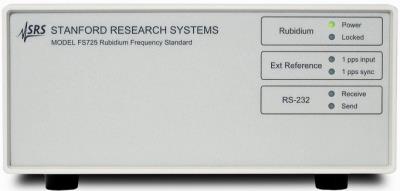
|
|
The Stanford Research Systems FS725 is a stand-alone 10 MHz frequency standard with an estimated 20-year aging of less than 0.005 ppm. The unit integrates an SRS PRS10 Rubidium Frequency Standard, a universal AC input power supply, and distribution amplifiers in a half-width 2U chassis (3.5" height). The unit's low aging eliminates the need for an external frequency reference in many applications; however units can phase-lock to an external 1 pps GPS signal for ageless performance or periodic calibration as required.
Specifications.
Standard outputs: Two 10 MHz sine waves, one 5 MHz sine wave, one 1 pps with 10 µs width.
1 pps output: 2.5 V into 50 Ω, 5 V into high impedance, 10 µs pulse width.
Sine outputs: 0.5 Vrms, ±10% (1.41 Vpp or +7 dBm).
Phase noise(5 MHz & 10 MHz):
<-130 dBc/Hz @ 10 Hz,
<-140 dBc/Hz @ 100 Hz,
<-150 dBc/Hz @ 1 kHz,
<-155 dBc/Hz @ 10 kHz.
Spurious: <-100 dBc (within 100 kHz).
Harmonics: <-60 dBc.
Return loss: >25 dB @ 10 MHz.
Accuracy: ±5 × 10-11.
Aging: <5 × 10-11 (monthly, after 1st month), <5 × 10-10 (yearly, after first year).
Allan variance:
<2 × 10-11 (1 s),
<1 × 10-11 (10 s),
<2 × 10-12 (100 s).
Holdover: 72 hour Stratum 1 (1×10-11).
Frequency retrace: ±5 x10-11 (72 hrs off then 72 hrs on).
Settability: <5 × 10-12.
Trim range: ±2 × 10-9 (pot or by 0-5 VDC input), ±0.5 ppm (via RS-232).
|